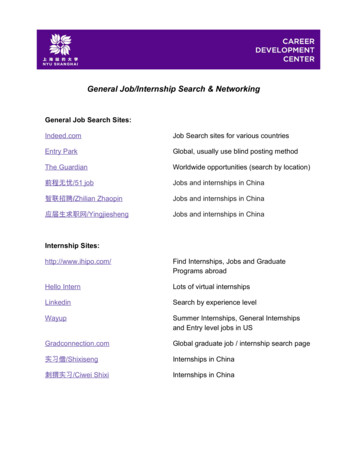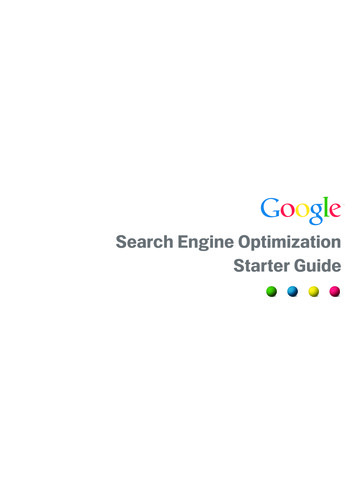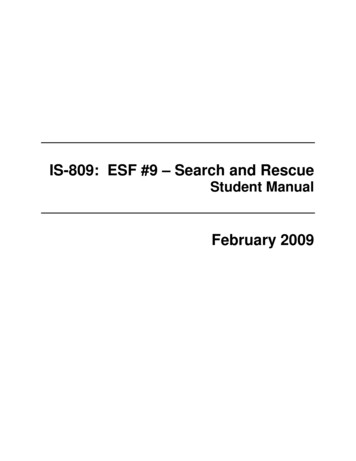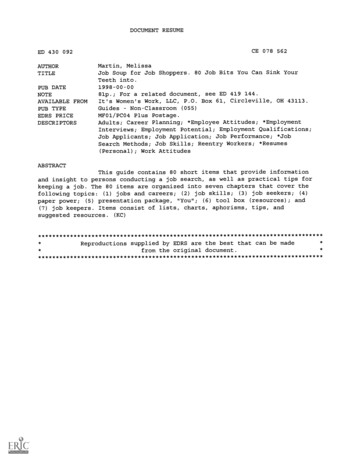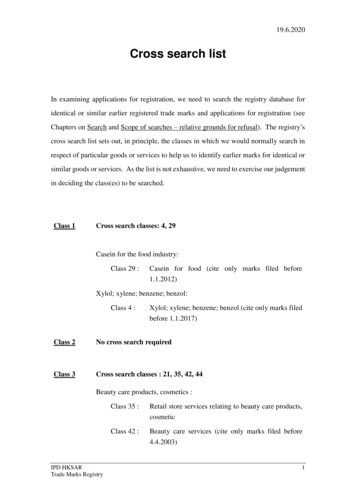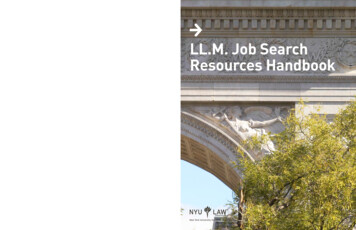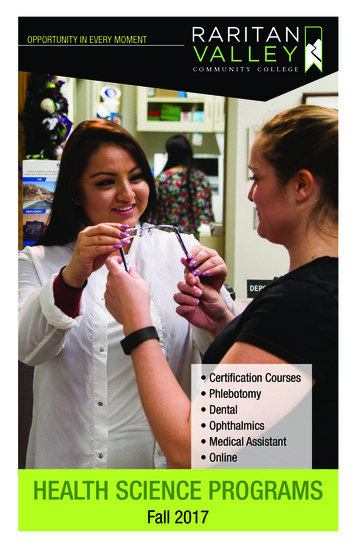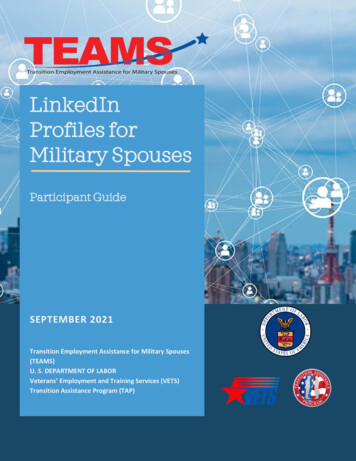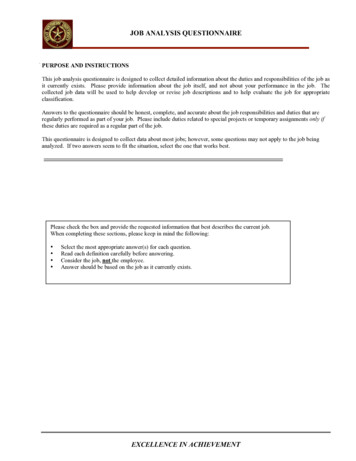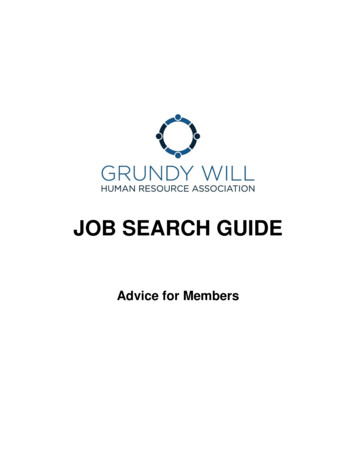
Transcription
JOB SEARCH GUIDEAdvice for Members
STAY CONNECTEDBetween jobs? Stay in touch with SHRM’s Transitioning Membership.Did you know that you can stay connected with HR information, tools, network and jobopportunities through SHRM’s complimentary transitioning membership?To apply, please visit www.shrm.org/members/transitioning.Transitioning benefits include: Full access to SHRM Online (shrm.org) Access to HR Jobs, including job alert e-mails Free participation in SHRM webcasts Access to the HR Knowledge Center Listing in the SHRM online membership directory Subscription to HR Magazine (U.S. only) Online publications including HR Magazine , Managing Smart and more Access to HR templates, toolkits and samples Online research, articles and white papers E-mail bulletins including HR Week, topical newsletters and more Discounts on SHRM professional developmentFor a comprehensive list of member benefits, visit www.shrm.org/memberkitTo apply, please visit www.shrm.org/members/transitioning(*The above was taken from SHRM membership renewal literature on 12/31/2015.Grundy Will Human Resource Association is not responsible for membership ratesoffered to those in transition. The above information may change without notice andwithout knowledge to the Grundy Will Human Resource Association.)2
Career ExplorationJob search. Transition. Looking for work. Exploring options. no matter how youdescribe it, the work of finding employment is a full-time job in itself.Being that the source of this information is coming from the Grundy Will HR Association,it’s safe to assume that you have at least narrowed your field down to HumanResources. That’s great! Now, let’s talk about what type of Human Resources work youare searching for. It’s important to start with this step; whether you are a long-termveteran of the field, or just starting out, there are a vast number of choices of “humanresources” work.A visit to www.onenet.org finds every description of work in the field, from HumanResources Manager to Industrial-Organization Psychologists. Each description will helpyou fine-tune the titles, tasks, tools & technology, skills, abilities, work activities, workcontext, job zone, education, interests, work styles, work values, related occupations,and wages & employment trends. That’s a lot of good information!Today’s job climate is not an easy one in which to make a career change. Employersare looking for experience. They want people who can hit the ground running andrequire as little training as possible. They also want people who are going to besuccessful and make their businesses more profitable. The best approach is to build onyour past successes by taking a look at what you do well and identifying yourtransferable skills, as it relates to what you read on www.onet.org. (You can tell we reallylike this site, right?)Another must visit site is www.shrm.org/hrdisciplines. SHRM (Society for HumanResources Management) breaks Human Resources down into the following categories:Benefits, Business Leadership & Strategy, Compensation, Consulting, Diversity,Employee Relations, Ethics & Corporate Responsibility, Global HR, Labor Relations,Organizational & Employee Development, Safety & Security, Staffing Management, andTechnology. What about being a “generalist”? Sure! But, consider the strategy ofbecoming an expert in one area as you continue to grow in your field. Honing in on anarea of expertise will allow to better define professional goals in ways that will maximizeyour income, brand your experience and help you recognize priorities of information andconnections.What we’ve been talking about so far is: Self-assessment (identify your skills andstrengths), Research and exploration (narrow your focus), Job Search Strategy (create aplan).Self-AssessmentSelf-assessment is the most useful and rewarding investment you can make in yourself,and it shouldn’t only happen while in transition. Take a continuous approach toidentifying your strengths and weaknesses.There are two possible approaches:3
1. More formal and structured: A few online assessments can be found atwww.keirsey.com, www.quintcareers.com, www.testingroom.com, orwww.rileyguide.com. Maybe you should start by first measuring your keystrengths: www.strengthsfinder.com . SHRM also makes personal competencytools available, specific to Human Resource ols.aspx2. Put pen to paper and identify your own skills, strengths, likes and dislikes.Questions to Answer1. What did you like about your past jobs? What did you dislike? Were yourdissatisfactions related to the content of your work, your company culture, or thepeople you work with?2. What are your marketable skills? What do you see as your strengths? Whattechnical skills do you have that an employer would be interested in?3. Do you like working on a team or prefer working independently? Do you enjoymanaging people?4. How quickly do you need to find a job? Are you willing and/or able to go back toschool? What are your financial needs? Are you open to relocation? Are theregeographic limitations for your job search?THREE CIRCLESNotice the three circles below. In simple terms, the picture shows us how to develop ourskills, interests, and abilities towards a “best fit” career or job.Stuff You Love To Do: In this circle youwill find things you consider hobbies orcauses you are passionate about --- timestands still when you are engaged inthese activities/efforts because yousimply love what you are working on.Stuff You’re Good At: In this circle arenatural or learned talents and tasks thatare easy for you to perform. Perhapsyou’ve always been good at organizingor you can just “see” how an HRISsoftware program works without knowingmuch about the detailed mechanics of it.Stuff Someone Will Pay You To Do: Inthis circle are all the things you’ve beenable to collect money doing – whether you enjoyed the job/task at hand or not. Theseinclude job titles, side jobs, and interests that have paid off no matter how large or small.Now, let’s put it all together:4
If Stuff you Love To Do overlaps Stuff You’re Good At, you are volunteering (foryourself or an organization). Brainstorm ways to shift towards Stuff Someone Will PayYou To Do.If Stuff You’re Good At Overlaps with Stuff Someone Will Pay You To Do, you’recollecting a paycheck but are likely not happy at your job. Are there ways to introducemore of what you love to do into your job? Or, do you need to expand your work/lifebalance in order to be happier overall, but not necessarily in your job?Where Stuff Someone Will Pay You To Do overlaps Stuff You Love To Do, withoutThings You’re Good At, you’ll find the need to ramp up your skills or learn to becomegood at what you’re doing. If you don’t find ways to be good at what you do, you’ll likelyfind yourself without a paycheck. Deficiencies in this circle are possible to overcome –you’ll just need to focus on learning and gaining experiences to help you get what youneed. Once you know what you are specifically looking for, you can find it or ask othersto help you find it!Take time to draw the diagram above and write words, skills, titles, and traits within eachcircle. The words within the circles are clues to lead you to career success. Analyzewhat you wrote in each and compare between the circles.Research and ExplorationNow that you have identified some guidelines, your next step is to map outspecific jobs and research them to find out whether they will suit you. Below areseveral different ways to approach this research. Brainstorm your ideas with friends and family. Utilize your public library. Library databases are often accessible online fromanywhere. Perform online research. There are thousands of online websites devoted tocareers. Check O-Net for specifics on skills, abilities, work activities andinterests associated with occupations at www.onetcenter.org. Look at jobpostings on www.shrm.org, www.indeed.com, www.careerbuilder.com andothers. Research salary information based on location and similar job titles onwww.indeed.com, www.salary.com, and www.glassdoor.com . Identify volunteer and freelance activities related to your field of interest. Talkto your SHRM Chapter’s Workforce Readiness Director for volunteeringpossibilities within your community. Investigate educational opportunities. Research classes at the localcommunity college. Go to a one-day or weekend seminar. Free (non-credit)courses can be taken online from highly regarded schools. These classes arecalled Massive Online Open Courses (MOOC). Access a few by visiting5
www.coursera.org. Contact professional networking groups in your target fieldfor suggestions and visit www.shrm.org for webinars and sessions. Look for ways to develop new skills in your current job which would pave theway for a change. Serve on a team related to your target area. Consider alternative roles within your industry which would utilize the industryknowledge you already have. It is easier to make a change from one field toanother within an industry than to change both fields and industries at thesame time. Ask for informational meetings. Contact people in the field you are interestedin and arrange to meet with them.How to Explore Careers Through Informational MeetingsThe following guidelines will help you ask and facilitate an informational meeting.Know What You Want to AccomplishThe primary objectives of informational meetings are to: Investigate a specific career field Assist in narrowing options Obtain advice on where you might fit in Learn the jargon and important issues in the field Broaden your network of contacts for future reference Create a strategy for entering your field of interestConducting an Informational MeetingBefore the meeting: Plan and write out questions you wish to ask Learn something about the person with whom you will be interviewing throughwww.LinkedIn.com or their company websiteDuring the interview: Restate your purpose for the meeting and be prepared to initiate the direction ofthe conversation since you called the meeting.Adhere to the original time request (20-30 minutes is probably ideal)Ask for referrals to other appropriate individuals in the field or in relatedorganizationsKeep in mind that this is an information-gathering and advice-seeking interview,not an employment interviewLet the individual you are interviewing bring up the discussion of specific jobvacanciesWhat to Ask If you were me, what steps would you take to land the position I’m looking for? Do you know of any trends right now that make you stop and think about how thefield will change in the next few years?6
Can you think of the actions or training you accomplished that made the mostdifference in your career advancement? Anything you would do differently?After the interview: Send a thank-you note and keep your contact posted on your progress Evaluate the meeting. What could you have done better? Use what you havelearned when you conduct your next meeting. Evaluate the information you received. How does it relate to your plans? Whatare your next steps?An informational interview enables you to gather information and establish contacts asyou build your plan for the future. Your next step is to plan your job search strategy.What is Your Job Search Strategy?How do you currently spend your job search time? Do you have a structured start andend time to your day? Do you have a plan for what you will accomplish during the dayand how you will go about completing tasks? Do you know the difference between tasksthat will indeed help you be successful and things that distract you from your goal offinding a new job? Do you balance job search time with hobbies and social time? Areyou able to keep from procrastinating job search tasks?These are all important questions to ask and evaluate as you carry out a successful jobsearch.How Do You Currently Spend Your Time?If you feel that conducting a job search is more work than actually working at a job,you’re right! Most job seekers will spend a minimum of 40 hours a week searching forwork. If you spend much more than 40 hours a week on a job search, you may very welldrain your energy and burn out, becoming unable to give your best effort and stayproductive. Structure your time. Set your alarm clock as if you were still getting to a job on time.Get up, get dressed, and find a work area that is yours and is set up to make themost of your time spent in that space.o Computer or laptop with internet connectiono Printer with a good supply of papero Files, folders, or binders to keep track of application submittalso Post-it notes and a bulletin board or space to post reminderso Calendaro Daily planner that you can carry with you to meetings, appointments, andinterviews. Keep frequently used phone numbers and website accessinformation in your planner or phone.Keep a to-do list and block out sections of time that will keep you focused on your jobsearch. During this time, do not check personal email, surf the internet, or makepersonal calls (unless they are job search related).Plan out each job search week on Mondays. Schedule appointments to talk topeople who can help you with your job search goals, networking group sessions andinformational meeting sessions for the week.7
Set aside a half hour at the same time each day, towards the end of your job searchwork day to make a list of the things you plan to accomplish the following day.Stop working on your job search around the same time each day (aside frommeetings/sessions after regular job search hours) and find some time to exerciseand spend time socializing with family and/or friends.Practice ways to relax and fall asleep in order to achieve 8-9 hours of sleep eachnight. Sometimes sleeping is hard when worry and anxiety of a job search is high.Find ways to take your mind off the worry. Read before going to bed, talk to acounselor or clergy member, practice yoga or meditate. Do not underestimate thisadvice. Rest helps you perform better at an interview!A Good Starting Place: Targeting Your Job SearchSelecting Job Targets: Having a strategic plan for which companies and positions youare searching for will help you focus your job search, maximize your networking effortsand make you a proactive job seeker.There are a number of factors to consider in selecting your targets: Geographic Location Company Size Position or Function Advancement Opportunities Work Environment Benefits Company Culture Salary Full Time or Part TimeSet a timer for 30 minutes and write out your five most important factors of your next position.Additionally, write about the company, your work surroundings, the structure of your work dayand responsibilities. Visualize a typical work day while your write.When the 30 minutes ends, take a break. Go for a walk or tackle another project for an hour. Atthat time, come back to your list and then identify specific companies or job titles that you arefamiliar with that match your five most important factors of your brainstorm list. If you havetrouble with this step, or if you feel you are not thinking of all the companies you should bethinking about, attend a networking session and specifically ask for people to give you additionalideas, talk to a business research librarian or call someone you already know who would haveinformation to help build your list. Be sure to have your list handy and make it as easy aspossible to help you continue brainstorming. Do not discard any suggestions anyone gives you.When you have a list of 15-20 companies or job titles, begin the task of researching your list. Visit each company’s website and make special note of positions listed on their careerpage/job postings. Research each company on LinkedIn to discover who you know who has connections tothe company. Make a list of previous companies where new employees have worked.Add these companies to your target list to research in the near future. Search for the company names and job titles from your list on search sites such aswww.indeed.com and www.careerbuilder.com . Continue to ask for information about the companies and titles on your list. Utilizediscussion boards on LinkedIn. Attend a few additional job clubs over the course of amonth, specifically mentioning the companies and job titles from your list. Your job at thisstage is to create possibilities through networking.8
Utilize your library! Intensive research databases exist and they are yours to use forfree.Why Is It So Important to Have Realistic Job Targets? Your job search will be more effective and efficient. Your presentation and paperworkwill be focused on the specifics of one job area rather than scattered around in manydifferent areas. You won’t waste time and energy filling out applications or tailoring resumes to jobs andcompanies where you would not be happy working. Nearly 80% of landings originate from networking --- talking to people at targetcompanies. Be certain to spend the majority of your job search time in line with thisresearch. Don’t spend too much time conducting your job search through outlets thatdon’t yield the best results.Job Search AnalysisAfter some time of building a list of specific companies and job titles, you will be able to createan analytical matrix like the one below.List open positions with target companies, or target job titles and their respective companies, onthe left side. Across the top fill in your key skills, experience, education and other criteria thatwas most important from the 30-minute brainstorming exercise. Check off across the page theelements that apply to the first target. Do the same for every target listed.Skills/Experience/Education/CriteriaEDA EnterpriseHR ManagerNo Travel ChicagoArea –within15 milesof home 10Min Sales Definite HRFocus Clear CompanyHR GeneralistPayrollAdminManageOthersBS inBusiness BonusOther HealthClubAllied IndustriesEmployee Development1-3 daysmonthly CarNow, what known opportunities (open positions) should be a priority on your to-do list? Whatare the next steps to move closer to employment with the opportunities on your matrix? Determine your deadline for applying to open positions with a company.o Even if a job posting is more than a couple of weeks old, continue with theapplication process. Tailor your cover letter and resume to each opportunity you find. When you do not find an open position with a company, try to connect to someone in thecompany who would be able to contact you at the first possible moment of an opening.o Asking for a meeting (either in person, via email, or over the phone) when aposition is not open is not the same as asking for a position --- you will need totalk to the person about the company or industry in general. Outright asking for ajob when there is no open position will make your contact hesitant to talk to you.8
Who Do You Already Know?Another way to brainstorm target companies is to create a list of people you talk to regularlythroughout the week, month, or year. Take another 30 minutes to write the names of all thepeople you know. This list should include relatives, neighbors, people you contact for services(hairdresser, lawn care, banking, etc.), former classmates, former co-workers, even people whoyou hear from only during holidays.Take another break after making this list and then behind the names, write the name of thecompany where each contact works. List any of their spouses’ workplaces if you know that aswell.After another break, circle the names of companies from your contact list that you would beinterested in learning more about as a potential employer. Research existing open positionswith the companies you’ve circled from this list and make a point to inform these inner circlecontacts of your plan to apply for a position within their company. Identify the companies that offer referral bonuses for new hires. Make good use of yourcontacts to get an interview! Most people in your inner circle are waiting to be told how they can specifically help youin your job search. People want to help you --- tell them how.o Forward your resume to people who show a genuine interest in helping you.o Make sure your message makes clear what kind of job you are looking for bybreaking complex job descriptions into short, easy to understand job titles.Common Job Search TasksTasks that will help you in your job search and should be scheduled on a regular basis include: Research time for target companies Internet searching for job postings Tailoring of resumes and cover letters Creating and polishing networking toolso Elevator Speecho Handbillo Business Cards Attending job clubs and workshops Attending personal development meetings and/or seminars Interview preparationo Build an interview portfolioo Clean and ready interview attire, vehicle, and personal appearanceo Practice interview questions and develop questions to ask the interviewer Send thank you notes to interviewers, networking contacts, and anyone who helps youalong the way Follow up to application submittals and interviews Reading about industry trends to stay current in your field Creating and updating your LinkedIn profile Researching job fairs and attending those appropriate for your targets9
Make Yourself AccountableCheck your job search progress at the end of each day and week. Have you accomplished yourgoals? When you do, reward yourself and keep up the good work! If you find that you’re notconsistently meeting your goals, explore why and decide what you need to do to succeed.Perhaps your goals were not realistic---you tried to do too much. Learn from this and plan morerealistic goals.It may be a good strategy to involve someone else in your search. Talk with a trusted friend;give them permission to hold you accountable to your plans. Or join an Accountability Group.Accountability Groups consist of 5-10 people meeting at the same time and place each week(preferably on Monday mornings) to broadcast their schedule and goals for the coming week.Group members help you determine ways to be successful by week end and help analyze shortfalls of the previous week’s efforts. You may also want to use an Accountability Group to splitup attendance of networking events and workshops. Each member would contribute copies ofhandouts or networking contacts, leads, or names of recruiters to the rest of the group.Keep Accurate RecordsIf you’re conducting a serious job campaign, you will make dozens of contacts and generatenew opportunities weekly. You need to have and maintain a filing system. There are a varietyof systems you can use including alphabetized three-ring binders, small pocket calendars andnotebooks. Just keep it easy to use and maintain, and don’t rely solely on database capacitywithin your phone.SummaryJob Search Strategy is about making the most of your time and finding places to look for jobs.A benefit of having a planned strategy to your job search is reduced stress. While there is noway to completely rid your life of job search stress when you are looking for a job, there arethings you can do to minimize stress. These things come from creating a plan that will help youfeel more in control of the things you can control. With a plan of action, you are now ready torevamp your resume and network.Resumes – General InformationPurpose of the ResumeAn effective resume achieves two goals: It presents a concise summary of your skills and accomplishments. It clearly establishes a relationship between your experience and your careerobjective in order to win an interview.General Guidelines for Writing Resumes New college graduates and people in entry-level positions should limit their resume to onepage. Professionals and those with extensive work experience may go to two pages. Toplevel executives might exceed two pages. Length of a resume is not a problem wrongcontent is a problem. No matter how short or long you write your resume, just make itrelevant in content.10
The recruiter or hiring manager who reads your resume will skim it quickly. It is importantthat your summary statement clearly conveys the type and level of employment you seek,and that the rest of your resume is written in a clear and concise, easy-to-read way. If you have many years of work experience, only include work history going back 10 - 15years if the responsibilities you had are highly relevant to your current goals. If you do wishto include earlier work history, summarize it into a short paragraph or a couple of bulletpoints under a separate heading of Previous Relevant Experience. Your resume should have perfect grammar, punctuation and spelling. Do not use personal pronouns and complete sentences in your resume, such as “I wasresponsible for ” Instead, state responsibilities or accomplishments in sentence fragments,such as “Led a cross-functional team that developed new marketing models for matureproducts.” Once you are satisfied that your resume effectively describes your skills andaccomplishments, shows the relationship between your experience and your goals, and isfree from errors, stop! Endless rewriting of your resume only slows down your job search. Because you will often use email to send your resume and communicating with employers,use an email address that is your name, e.g. MarySmith@hotmail.com instead ofpookybear@hotmail.com. Use a descriptive name for your resume document, e.g.“MarySmithResume.doc” instead of “resume.doc.”Resume ToolkitTypes of ResumesThe format you choose for your resume is essential to its impact. The format you chooseshould focus the reader on those skills, experience or achievements that connect most clearlywith your career goals and the position for which you are applying.Resume ComponentsResumes are made up of component parts, and not every section will be applicable to you. Thefollowing information identifies and defines these component parts.Heading: List your name, credentials (SPHR, PHR, etc.) address, phone number, emailaddress, and a LinkedIn account url.Summary: Your summary statement creates a frame of reference for the reader. The formatand content of your resume should be constructed to reflect and support your summary. Thesummary can be a 2-4 sentence paragraph.Experience: You may include a mixture of paid and unpaid work, listed in reverse chronologicalorder. Each experience includes your position title, dates of service (year to year is sufficient),and the organization’s name, city and state. Whether you emphasize position titles or employernames depends upon what you are trying to accomplish. For example, if you wish to changeindustries but stay in the same job function, emphasize job titles. If you wish to capitalize on thenames of former employers (because they are well known or respected), emphasize employernames.11
When describing your experience, highlight the skills you demonstrated as well as the results ofyour work. Whenever possible, you should quantify the outcomes of your efforts. Descriptionsof work experience should either be bullet points or a 2-3 sentence introductory statementfollowed by bullet points. Do not use more than five bullet points per role, unless highly relevantto the targeted position.When including volunteer or unpaid experience, be sure to use the word “Volunteer” in the jobtitle. Only include achievement statements that demonstrate professional competencies.Areas of Expertise: This category can also be named Accomplishments or Skills, or you maylist several categories of skills, e.g. Project Management, Technical Skills, and Laor Relations.Education: List degrees earned, schools attended, and areas of study, with the most recentdegree appearing first. You need not note attendance at other colleges (for example,community college if you subsequently earned a Bachelor’s degree at another college).Professional training you received through former employers and certifications may be includedunder the Education category. New college graduates may include graduation date, GradePoint Average, academic honors, thesis subject and a short listing of relevant coursework.Professional Associations and Memberships: This component can include school-relatedactivities, community activities, and professional memberships. You may also include anyhonors or awards you have received, and offices held in organizations. Include only thoseactivities that relate to and support your Professional Summary. Do not mention religious orpolitical affiliations.Military Service: Mention branch of service, rank and relevant training or responsibilities.References: It is not necessary to list references, or to tell the employer that they may requestreferences. Bring with you to an interview your reference sheet.Writing Your Summary StatementThe summary statement (also called the Professional Summary, Professional Profile,Professional Highlights, Summary, or Profile) communicates in just a few sentences and/orbullet points, the type of position you are seeking and key aspects of your qualifications. It hasto be brief enough to be read it in a few seconds, but must interest the reader enough to want toread the rest of your resume. Give careful thought to what your targets are: industry, type of job, and level ofresponsibility. Use a generic job title or description that will be understood in anyorganization that has this job function. Also think about what value you will bring to anorganization in terms of your skills and accomplishments. The Summary statement should focus on the job and your qualifications, not what you hopeto get from the job. Stay away from statements such as “seeking a position that will utilizemy skills,” “seeking a position with benefits,” or other statements about what you hope to getfrom the employer.Examples of Summary StatementsHuman Resources Director with 14 years’ experience at local, regional and national levels.Areas
Subscription to HR Magazine (U.S. only) Online publications including HR Magazine , Managing Smart and more Access to HR templates, toolkits and samples Online research, articles and white papers E-mail bulletins including HR Week, topical newsletters and more Di

